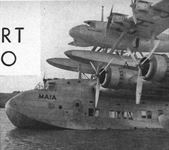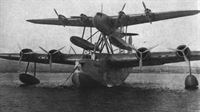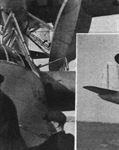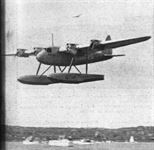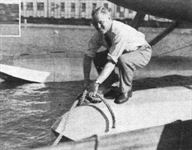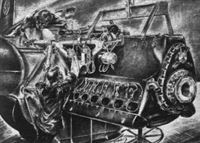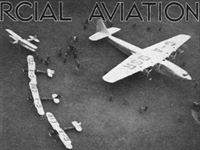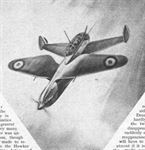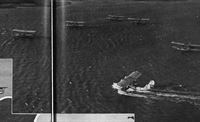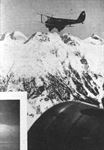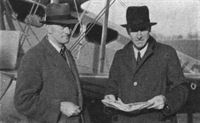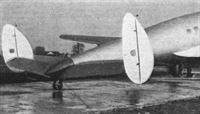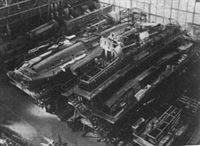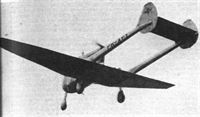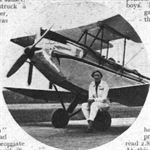Фотографии
-
Регистрационный номер: PH-AKJ, PH-ALV A photograph of the general maintenance shops, one of many devoted to different items of equipment. The machine on the left of the picture will be recognised as one of the D.C.3s used by K.L.M. on their Batavia service
Самолёты на фотографии: Douglas DC-1 / DC-2 / C-32 / C-39 - США - 1933Douglas DC-3 / C-47 Skytrain/С-53 Skytrooper / Dakota - США - 1935
-
FLEET FIGHTER PROTOTYPE: The new experimental Grumman mid-wing single-seater fleet fighter for the U.S. Navy. A Pratt and Whitney Twin Wasp engine is fitted and the undercarriage retracts into the bottom of the fuselage, as with the Grumman biplanes now in service.
Самолёты на фотографии: Grumman F4F Wildcat - США - 1937
-
Chinese Curtiss Hawks with Wright Cyclone engines and retractable undercarriages. It may be significant that the cockpit enclosures have been removed.
Самолёты на фотографии: Curtiss F11C-3 / Hawk III / BF2C-1 / Model 68 - США - 1933
-
Регистрационный номер: K5083 DEFENCE OF ENGLAND. The Hawker Hurricane with Rolls-Royce Merlin Engine is now in large-scale production for the Air Ministry.
Самолёты на фотографии: Hawker Hurricane - Великобритания - 1935
-
Регистрационный номер: L1547 THE HURRYCANE: The production-model Hawker Hurricane.
Самолёты на фотографии: Hawker Hurricane - Великобритания - 1935
-
The Italian Royal Air Force crews of the three Savoias. Lt. Bruno Mussolini is third from the left, back row. In the centre of the row is Col. Biseo, and Capt. Moscatelli is standing at his left.
Самолёты на фотографии: Savoia-Marchetti / SIAI SM.79 Sparviero - Италия - 1934
-
BATTLE ARRAY: This flight of Fairey Battles has that grimly purposeful air which always seems to distinguish the modern medium bomber dressed in camouflage. In large-scale production, and now forming the equipment of several R.A.F. squadrons, the Battle has the Rolls-Royce Merlin II engine. Top speed is 257 m.p.h. at 15,000ft.
Самолёты на фотографии: Fairey Battle - Великобритания - 1936
-
Регистрационный номер: G-ADHJ [7], G-ADHK [7] Самолёты на фотографии: Short Mayo Composite (S.20 Mercury and S.21 Maia) - Великобритания - 1938
-
Регистрационный номер: G-ADHJ [7], G-ADHK [7] Picking up moorings after a flight. Mr. Lankester Parker is seen in the cabin of Maia, while Mr. Piper, who has had to scurry down from his perch in Mercury, is in the bow compartment making fast to one of the rubber buoys which are used exclusively at Rochester, and which were the invention of the late Mr. Eustace Short.
Самолёты на фотографии: Short Mayo Composite (S.20 Mercury and S.21 Maia) - Великобритания - 1938
-
Регистрационный номер: G-ADHJ [7], G-ADHK [7] Getting ready for the great event. Mr. Piper goes on board Mercury, which is resting on the special supports on the Maia.
Самолёты на фотографии: Short Mayo Composite (S.20 Mercury and S.21 Maia) - Великобритания - 1938
-
Регистрационный номер: G-ADHJ [7] After the successful separation Mr. Piper gave a fine demonstration of high-speed flying before alighting off the Short works at Rochester.
Самолёты на фотографии: Short Mayo Composite (S.20 Mercury and S.21 Maia) - Великобритания - 1938
-
Регистрационный номер: G-ADHK [7] Mr. Lankester Parker, who piloted Maia, inspects his “clocks” in the inset picture.
Самолёты на фотографии: Short Mayo Composite (S.20 Mercury and S.21 Maia) - Великобритания - 1938
-
Регистрационный номер: G-ADHJ [7] Mr. Piper is seen mooring Mercury.
Самолёты на фотографии: Short Mayo Composite (S.20 Mercury and S.21 Maia) - Великобритания - 1938
-
Регистрационный номер: G-ADHJ [7], G-ADHK [7] Maia and Mercury as a composite, or eight-engined, biplane.
Самолёты на фотографии: Short Mayo Composite (S.20 Mercury and S.21 Maia) - Великобритания - 1938
-
Регистрационный номер: G-ADHJ [7] A view inside Mercury, looking forward.
Самолёты на фотографии: Short Mayo Composite (S.20 Mercury and S.21 Maia) - Великобритания - 1938
-
Регистрационный номер: G-ADHK [7] The indicating lights which show the trim and pull of the upper component at any given moment.
Самолёты на фотографии: Short Mayo Composite (S.20 Mercury and S.21 Maia) - Великобритания - 1938
-
Регистрационный номер: G-ADHK [7] The cockpit of the Maia
Самолёты на фотографии: Short Mayo Composite (S.20 Mercury and S.21 Maia) - Великобритания - 1938
-
How it is done: the interiors of the Short-Mayo units
Самолёты на фотографии: Short Mayo Composite (S.20 Mercury and S.21 Maia) - Великобритания - 1938
-
Structural details of Mercury are revealed by these Flight sketches. The central drawing shows the complete machine, with covering partly removed, and the lettered arrows give a clue to the locations of the structural features which are shown in greater detail in the other sketches.
Spar and rib construction is shown in A as well as in the large drawing at the top of the page. Extruded sections form the corners of the spar box, and the leading edge is built up as shown in B. Details of the tubular bracing of the spar box are illustrated in C, and the construction of the region where the wing joins the fuselage is revealed in D.
The large sketch also shows main constructional features of the fuselage of Mercury. It is built rather like a boat hull, and has a stout central keel, on which the weight of the machine is taken when it rests on the trestle on top of Maia’s wing.Самолёты на фотографии: Short Mayo Composite (S.20 Mercury and S.21 Maia) - Великобритания - 1938
-
Регистрационный номер: D-AFAY Military-type He.111 medium bombers which must do nearer 300 than 250 m.p.h.
Самолёты на фотографии: Heinkel He-111 - Германия - 1935
-
A "shot" through the nose turret of a He.111 bomber.
Самолёты на фотографии: Heinkel He-111 - Германия - 1935
-
A German artist’s impression: Mounting a Daimler-Benz DB 600 inverted vee in a He.111. The original version of this machine had vee-twelve B.M.W.s.
Самолёты на фотографии: Heinkel He-111 - Германия - 1935
-
Регистрационный номер: G-ACCL, G-ACNF, G-ADSR, G-AEIR Proportion: The first A.W. Ensign, now at Coventry, with a few attendants from the A.S.T. school fleet at Hamble.
Самолёты на фотографии: Armstrong Whitworth Ensign / A.W.27 - Великобритания - 1938Avro Cadet / Type 631/643 - Великобритания - 1932
-
The unorthodox French Delanne now under construction. A top speed of 370 m.p.h. is calculated, with an Hispano Suiza Series Y engine. The excrescences are a shell-gun and a radio mast.
Самолёты на фотографии: Arsenal-Delanne 10-C2 - Франция - 1941
-
HELICOPTER CONTROLLABILITY: Fraulein Hanna Reitsch making her remarkable indoor flight with the Focke-Wulf helicopter in the Deutschlandhalle, Berlin. Horizontal motion is obtained from the rotors, and not from the airscrew, which acts mainly as a cooling fan.
Самолёты на фотографии: Focke-Wulf FW.61 - Германия - 1936
-
Регистрационный номер: L4212 The protoype Wellington, Mk 1 L4212, was first flown on December 23, 1937 from Brooklands and is seen landing there in January 1938.
Самолёты на фотографии: Vickers Wellington / Type 271 - Великобритания - 1936
-
“This desirable Tudor residence” is suggested by the geodetic window-panes of the Vickers Wellington I medium bomber (two Bristol Pegasus with two-speed superchargers), but the performance is anything but medieval. This, the production job - photographed by Flight Brooklands last week - has been very considerably cleaned-up as compared with the prototype which, it may be remembered, had an oddly insect-like bulge at the tip of the tail. The unfamiliar fittings within the collector rings are Vickers crankcase cowlings.
Самолёты на фотографии: Vickers Wellington / Type 271 - Великобритания - 1936
-
Регистрационный номер: K5909 Самолёты на фотографии: Saunders-Roe London / A.27 - Великобритания - 1934
-
Two Mark I Londons in the air.
Самолёты на фотографии: Saunders-Roe London / A.27 - Великобритания - 1934
-
A London has just alighted and is taxying up to its moorings.
Самолёты на фотографии: Saunders-Roe London / A.27 - Великобритания - 1934
-
The moorings at Calshot. A Saro London of No. 201 Sqn. has just landed, while two more Londons and three Supermarine Scapas are moored out. The Scapas belong to the training squadron.
Самолёты на фотографии: Saunders-Roe London / A.27 - Великобритания - 1934Supermarine Scapa - Великобритания - 1932
-
Регистрационный номер: K5257 Going down the slipway - a picture which gives a good idea of the rear gunner’s cockpit and of the clear field of fire which is obtained from it between the twin rudders and fins.
Самолёты на фотографии: Saunders-Roe London / A.27 - Великобритания - 1934
-
Регистрационный номер: HB-APA A snap of Swissair’s Rapide taken while the two machines were flying in photographic formation over St. Moritz.
Самолёты на фотографии: De Havilland Dragon Rapide / Dominie / D.H.89 - Великобритания - 1934
-
COMFORTABLY TO KENYA: Capt. G. de Havilland and Mr. F. T. Hearle (left) have delivered a Wilson Airways Dragon Rapide by easy stages to Kenya. Mr. Hearle has been a colleague of "D.H." since 1908, when he helped him build his first machine.
Самолёты на фотографии: De Havilland Dragon Rapide / Dominie / D.H.89 - Великобритания - 1934
-
Two views of the interior of the survey Dragon. The first of them shows the cabin arrangements with the drift sight, linking unit and D/F receiver on the left; the two axis control unit and short-wave receiver in the centre; and the transmitter and the camera cradle stabiliser on the right. Through the door beyond the transmitter may be seen the automatic pilot control panel. The picture on the right shows the installation in the pilot’s cockpit, with the loop control, direction-finding receiver and charging switchboard. The lateral automatic unit is below the pilot’s seat.
Самолёты на фотографии: De Havilland Dragon Rapide / Dominie / D.H.89 - Великобритания - 1934
-
Самолёты на фотографии: Handley Page Harrow / H.P.54 - Великобритания - 1936
-
Регистрационный номер: HB-ITA ST. MORITZ STUDY. A fine impression of a Swissair Douglas D.C.2 taking off from the new “fine-weather” airport at Samaden {5,500 ft. above sea level), which is proving so useful to winter sports visitors to St. Moritz.
Самолёты на фотографии: Douglas DC-1 / DC-2 / C-32 / C-39 - США - 1933
-
Past and Future: A striking impression of the Stearman Hammond and one of K.L.M.’s D.C.2s on the tarmac at Croydon. The Hammond is, of course, being used to accustom the company’s pilots to the tricycle technique in preparation for possible operation of Douglas D.C.4s in due course. The Hammond is, however, primarily interesting as a private type - or as the basis of future private types.
Самолёты на фотографии: Douglas DC-1 / DC-2 / C-32 / C-39 - США - 1933Stearman-Hammond Y-1 - США - 1936
-
Самолёты на фотографии: Douglas DC-1 / DC-2 / C-32 / C-39 - США - 1933
-
The photograph of the Oberland south of Glarus gives a good impression of the type of scenery which is enjoyed by the Alpine air traveller.
Самолёты на фотографии: Douglas DC-1 / DC-2 / C-32 / C-39 - США - 1933
-
The enclosed cockpits of one of the Canadian-built Tiger Moths. The protective rubber covering for the instrument panel, and the "jacket" for the oil tank, are among the noticeable features.
Самолёты на фотографии: De Havilland Tiger Moth / D.H.82 - Великобритания - 1931
-
The D.H. Albatross takes the air with her new cantilever tailplane. She now has an automatic pilot and leading-edge anti-icing equipment. Mr. Geoffrey de Havilland was the pilot when Flight's photographer secured this picture.
Самолёты на фотографии: De Havilland Albatross / D.H.91 - Великобритания - 1937
-
TAIL-PIECE: A close-up of the full cantilever tail of the D.H. Albatross. The rudders have been placed at the extreme tips, and the tailplane has a sharp dihedral. The modification is intended to ensure positive stability under all conditions of flight - this is particularly important for blind take-offs over a wide range of loadings and load dispositions.
Самолёты на фотографии: De Havilland Albatross / D.H.91 - Великобритания - 1937
-
A flight of R.A.A.F. Hawker Demons (R.R. Kestrel II) over Australia’s new “streamlined” train.
Самолёты на фотографии: Hawker Demon - Великобритания - 1932
-
Регистрационный номер: J9933 A Hawker Demon with Nash and Thompson gun turret. The Demon has been the standard R.A.F. two-seater fighter for seven years.
Самолёты на фотографии: Hawker Demon - Великобритания - 1932
-
The Miles Kestrel Trainer which would make a very good first-line two-seater fighter, having a speed of 295 m.p.h.
Самолёты на фотографии: Miles Kestrel M.9 / Master I M.9A - Великобритания - 1937
-
Регистрационный номер: G-AEUA Самолёты на фотографии: Short Empire / S.23 - Великобритания - 1936
-
SURVEY FLIGHT: A striking study from the Empire boat, Centaurus, passing Mount Egmont, New Zealand, during her recent survey trip to the Dominion.
Самолёты на фотографии: Short Empire / S.23 - Великобритания - 1936
-
Регистрационный номер: G-AEZZ ATTRACTIVE HIGH-WING: The latest Wicko, with Gipsy Major engine. It carries two at a cruising speed of 120 m.p.h. (136 m.p.h. maximum), and has a range of 500 miles. The makers are the Foster, Wikner Aircraft Co., Ltd., Southampton Airport.
Самолёты на фотографии: Foster Wikner Wicko - Великобритания - 1936
-
Регистрационный номер: D-EBYI SANTA CLAUS’ WORKSHOP: German Bucker Jungmanns, popular for ab initio and aerobatic training, stood on their noses to save hangar space.
Самолёты на фотографии: Bucker Bu.131 Jungmann - Германия - 1934
-
Регистрационный номер: D-ELIO For dual, not duels: “Student” is the type-name of this new monoplane from the German Bucker works, which have achieved unusual success in a comparatively short time with their biplane trainers. Intended for private - owner and primary school use, it is said to cruise at 100 m.p.h. on the 55 h.p. of the Czecho-Slovakian Walter Mikron four-in-line. A range of 400 miles and fuel consumption of 2.4 galls./hr. are claimed.
Самолёты на фотографии: Bucker Bu.180 Student - Германия - 1937
-
A new Heinkel dive-bomber attack monoplane, surely one of the shapeliest aeroplanes ever built.
Самолёты на фотографии: Heinkel He-118 - Германия - 1935
-
Accent on manoeuvrability: the Koolhoven F.K.52 (Bristol Mercury) a two-seater fighter with four guns.
Самолёты на фотографии: Koolhoven FK-52 - Нидерланды - 1937
-
Регистрационный номер: NC18388 DECEPTIVE APPEARANCE: The new American Barkley-Grow light transport with two 400 h.p. Wasp Juniors. Although this machine looks like a Lockheed 12 with a fixed undercarriage, its structure is really unique, the wing having no ribs or bulkheads. A top speed of 225 m.p.h. is claimed and the payload (six passengers, freight and baggage) is 1,450 lb.
Самолёты на фотографии: Barkley-Grow T8P-1 - США - 1937
-
D.C.4 TAKES SHAPE: Reminiscent of a power station with its dynamos, a section of the Douglas works is devoted to the construction of the four-engined D.C.4 transport. Fuselage and wings can be seen in separate erection cradles. Weighing 65,000 lb. the machine will carry 42 passengers, a crew of five, several tons of baggage and fuel for a range of 2,200 miles. Production models will have “supercharged” cabins.
Самолёты на фотографии: Douglas DC-4E - США - 1938
-
The first application of the tricycle undercarriage to a big commercial aeroplane - the forthcoming 40-passenger Douglas D.C.4 The photograph appears to have been made with the aid of a model.
Самолёты на фотографии: Douglas DC-4E - США - 1938
-
Самолёты на фотографии: Sikorsky S-42 Clipper - США - 1934
-
Регистрационный номер: PH-APY [3] Самолёты на фотографии: Stearman-Hammond Y-1 - США - 1936
-
Регистрационный номер: PH-APY [3] Flying view of the Hammond taken during the machine’s short visit to this country last year. The one-piece flap extends between the tail booms, which must, incidentally, have given the designers food for thought while working on the layout of the elevator controls. The rudders are fixed.
Самолёты на фотографии: Stearman-Hammond Y-1 - США - 1936
-
Регистрационный номер: PH-APY [3] If the position of undercarriage legs in this ground view of the Hammond is compared with that in the flying pictures, the amount of movement will be appreciated; the tricycle type of undercarriage permits an almost unlimited travel since the ground angle need not be considered. Ease of entry into the cabin is an obviously good feature of a machine on pusher-tricycle lines.
Самолёты на фотографии: Stearman-Hammond Y-1 - США - 1936
-
SOMETHING DIFFERENT FROM THE STATES: First views of the new Timm light transport (two 400 h.p. Wasp Juniors) which has Handley Page slots and a tricycle undercarriage. Spats and other fairings had not been installed when these snapshots were secured. This machine is one of several new American types to be built largely of wood. The top speed is about 200 m.p.h.
Самолёты на фотографии: Timm T-840 Aeromold Transport - США - 1938
-
Like most unorthodox pieces of machinery, the Everel airscrew looks a little uncouth until one becomes used to its appearance. In the picture is seen the take-off demonstration, with the Everel-fitted Cub nearest the camera; both had left the same mark simultaneously.
Самолёты на фотографии: Taylor Cub - США - 1931
-
Hts Majesty arrives in the Royal Airspeed Envoy and salutes as the Royal Standard is broken.
Самолёты на фотографии: Airspeed Envoy / AS.6 - Великобритания - 1934
-
JAPANESE “HEAVY”: A heavy bomber of the Japanese Navy believed to te of the Navy 96 type. The engines are B.M.W.s of old vintage built under licence.
Самолёты на фотографии: Hiro G2H - Япония - 1933
-
Pupils and instructor, with trophy, in front of a Koolhoven - one of those used for training and charter work.
Самолёты на фотографии: Koolhoven FK-43 - Нидерланды - 1931
-
Регистрационный номер: PH-AFM Ground instruction: A group of future K.L.M. pilots with one of the Panders used by the National Flying School.
Самолёты на фотографии: Pander E - Нидерланды - 1926
-
Самолёты на фотографии: De Havilland Gipsy Moth / Moth X - Великобритания - 1928
-
Самолёты на фотографии: De Havilland Gipsy Moth / Moth X - Великобритания - 1928
-
Регистрационный номер: G-AEMA [5] The flying picture gives a good idea of its smooth lines with the new cabin top and production finish.
Самолёты на фотографии: C.W. Aircraft Cygnet - Великобритания - 1937
-
Регистрационный номер: G-AEMA [5] The Cygnet’s two-piece flap gear in the “down” position
Самолёты на фотографии: C.W. Aircraft Cygnet - Великобритания - 1937
-
Регистрационный номер: G-AEMA [5] SPECIALISED LUGGAGE: One way of overcoming the luggage accommodation difficulty. Specially built and fitted suitcases are designed for the production model of the C.W. Cygnet
Самолёты на фотографии: C.W. Aircraft Cygnet - Великобритания - 1937
-
Регистрационный номер: G-AEMA [5] The wide doors of the Cygnet may be fixed in any position by means of the adjustable stops, and this photograph also shows the neat instrument panel layout, with the easily seen and reached fuel tap immediately below it. The amount of transparent area is noteworthy.
Самолёты на фотографии: C.W. Aircraft Cygnet - Великобритания - 1937
-
Регистрационный номер: G-AEMA [5] Two typical ground views, showing in each case the tidy cantilever undercarriage, which certainly gives an impression of ground stability
Самолёты на фотографии: C.W. Aircraft Cygnet - Великобритания - 1937
Статьи
- Flight
- Flight Advertisements







